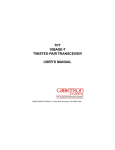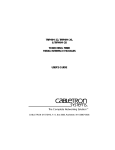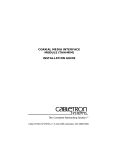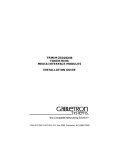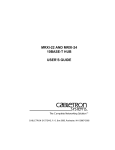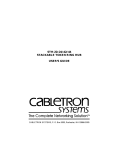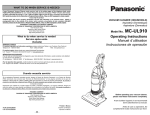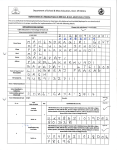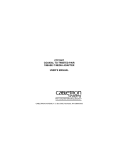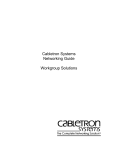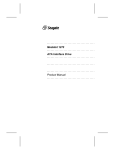Download Cabletron Systems MR-9T Installation guide
Transcript
MR9T IEEE 802.3 10BASE-T MR9T-C IEEE 802.3 10BASE-T/10BASE-2 MULTIPORT REPEATER INSTALLATION GUIDE CABLETRON SYSTEMS, P. O. Box 5005, Rochester, NH 03866-5005 NOTICE NOTICE Cabletron Systems reserves the right to make changes in specifications and other information contained in this document without prior notice. The reader should in all cases consult Cabletron Systems to determine whether any such changes have been made. The hardware, firmware, or software described in this manual is subject to change without notice. IN NO EVENT SHALL CABLETRON SYSTEMS BE LIABLE FOR ANY INCIDENTAL, INDIRECT, SPECIAL, OR CONSEQUENTIAL DAMAGES WHATSOEVER (INCLUDING BUT NOT LIMITED TO LOST PROFITS) ARISING OUT OF OR RELATED TO THIS MANUAL OR THE INFORMATION CONTAINED IN IT, EVEN IF CABLETRON SYSTEMS HAS BEEN ADVISED OF, KNOWN, OR SHOULD HAVE KNOWN, THE POSSIBILITY OF SUCH DAMAGES. Copyright June 1992 by Cabletron Systems, Inc. P.O. Box 5005, Rochester, NH 03867-0505 All Rights Reserved Printed in the United States of America Order number: 9030521-01 June 1992 LANVIEW is a registered trademark and MMAC, MR9T-C, and MR9T are trademarks of Cabletron Systems, Inc. Ethernet is a trademark of Xerox Corp. Velcro is a registered trademark of Velcro Industries, B.V. i FCC NOTICE FCC NOTICE WARNING: This equipment has been tested and found to comply with the limits for a Class A digital device, pursuant to Part 15 protection against harmful interference when the equipment is operated in a commercial environment. This equipment uses, generates, and can radiate radio frequency energy and if not installed in accordance with the operator’s manual, may cause harmful interference to radio communications. Operation of this equipment in a residential area is likely to cause interference in which case the user will be required at his own expense to correct the interference. If this equipment does cause interference to radio or television, which can be determined by turning the equipment off and on, the user is encouraged to try to correct the interference by one or more of the following measures: • • • • Re-orient the receiving antenna. Relocate the repeater with respect to the computer. Move the repeater away from the receiver. Plug the repeater into a different outlet so that the computer and the repeater are on different branch circuits. If necessary, you should consult the dealer or an experienced radio/ television technician for additional suggestions. You may find the following Federal Communication Commission booklet helpful: “Interference Handbook” This booklet is available from the U.S. Government Printing Office, Washington D.C. 20402 - Stock No. 004-000-00482-5. ii CONTENTS CONTENTS CHAPTER 1 INTRODUCTION 1.1 1.2 1.3 Using This Manual ....................................................................1-1 Getting Help ...............................................................................1-2 Overview .....................................................................................1-2 CHAPTER 2 SPECIFICATIONS AND REQUIREMENTS 2.1 2.2 2.3 Specifications..............................................................................2-1 General Specifications ...............................................................2-1 Twisted Pair Connectors ...........................................................2-2 BNC Interface (Port 9, MR9T-C) ..............................................2-3 Power Supply .............................................................................2-4 Environmental ...........................................................................2-4 Safety ........................................................................................2-4 Physical ......................................................................................2-4 10BASE-T Network Design Guidelines: MR9T........................2-5 10BASE-2 Network Design Guidelines: MR9T-C .................... 2-6 CHAPTER 3 INSTALLATION 3.1 3.2 3.3 3.4 3.5 3.6 Mounting the MR9 .....................................................................3-1 Connecting the MR9 to the Power Source ................................3-2 Strain Relief for the Power Cord ...............................................3-2 Connecting Cables .....................................................................3-3 3.4.1 Cross-Over and Straight-Through ...............................3-3 Connecting the Network Segment ............................................3-4 Connecting Twisted Pair Segments to RJ-45 Ports .................3-6 CHAPTER 4 USING LANVIEW 4.1 The LANVIEW Indicators .........................................................4-1 iii INTRODUCTION CHAPTER 1 INTRODUCTION The MR9T-C 10BASE-T/10BASE-2 Multiport Twisted Pair Repeater (Figure 1-1) and the MR9T 10BASE-T Multiport Twisted Pair Repeater (Figure 1-2) conform to all applicable IEEE 802.3 specifications. Each repeater has nine ports. Ports 1 through 8 on both models are 10BASE-T compliant RJ-45 ports. Port 9 is where the two repeater models differ. Port 9 on the MR9T has an RJ-45 connector. In addition, the MR9T has a special switch that alters the pin configuration of Port 9. On the MR9T-C, Port 9 is a BNC connector for a thin-coax connection. The MR9T-C also has a switchselectable internal 50 ohm terminator. 1.1 USING THIS MANUAL Unless otherwise noted, this manual refers to both the MR9T and MR9T-C as the MR9. Chapter 1, Introduction, describes the differences between the MR9T and the MR9T-C and explains the product features. Chapter 2, Specifications and Requirements, contains operating specifications for the MR9. This chapter also includes the location requirements for the MR9 and network design guidelines for connecting the MR9 to the network. Chapter 3, Installation, contains instructions for installing the MR9 and connecting it to your network. Chapter 4, Using LANVIEW, contains a functional description of the LANVIEW indicators. This manual assumes that you have a general working knowledge of Ethernet or IEEE 802.3 type data communications networks and their physical layer components. Page 1-1 INTRODUCTION 1.2 GETTING HELP If you need additional support related to the MR9, or if you have any questions, comments, or suggestions related to this manual, contact Cabletron Systems Technical Support. Before calling, please have the following information ready: • The product type (MR9T or MR9T-C) and the product serial number. The serial number is located on the front panel of the repeater. You can contact Cabletron Systems Technical Support by any of the following methods: By phone: Monday through Friday between 8 A.M. and 8 P.M. Eastern Standard Time at (603) 332-9400. By Compuserve: GO CTRON from any ! By Internet mail: [email protected] 1.3 OVERVIEW The MR9T and MR9T-C have eight internally crossed-over RJ-45 ports. The MR9T has a ninth RJ-45 port which is switch-selectable for a cross-over or a straight-through pin configuration. (For an explanation of cross-over and straight-through, see Chapter 3, Installation.) The configuration switch gives you complete flexibility to connect to other twisted pair Ethernet devices without using specially configured cable segments. All RJ-45 ports incorporate a polarity detection and correction feature which lets the repeater pass data regardless of the polarity of a port’s twisted pair receive link. On the MR9T-C, Port 9 has a thin-net coaxial male BNC connector instead of an RJ-45 connector. Instead of a configuration switch, the MR9T-C has a termination switch that lets you activate an internal 50 ohm cable terminator for Port 9. You can use any port to connect the MR9T directly to an Ethernet network, though Port 9 is normally used for the network connection. Typically, the MR9T connects to a network hub, such as Cabletron Systems’ MMAC series. The MR9T-C can connect to a network hub, or directly to an Ethernet coax cable through a transceiver. Page 1-2 INTRODUCTION PWR MR9T-C RCV CLN LNK PORT 9 8 7 6 5 4 3 2 1 POWER INPUT 802.3 10BASE-T/10BASE2 MULTI PORT REPEATER WITH LANVIEW THIS DEVICE COMPLIES WITH PART 15 OF THE FCC RULES. OPERATION IS SUBJECT TO THE FOLLOWING TWO CONDITIONS: (1) THIS DEVICE MAY NOT CAUSE INTERFERENCE, AND (2) THIS DEVICE MUST ACCEPT ANY INTERFERENCE RECEIVED, INCLUDING INTERFERENCE THAT MAY CAUSE UNDESIRED OPERATION. POWER REQUIRED: 15V - - - , 900mA MAX DATA CAPABILITY: 10Mb/s LISTED TERM PORT 9 8X 7X UL SN The Complete Networking Solution 6X 5X TUV Rheinland 16EO ITE REPEATER UNIT 4X 3X 2X 1X Figure 1-1. The MR9T-C PWR MR9T RCV CLN LNK PORT 9 8 7 6 5 4 3 2 1 POWER INPUT 802.3 10BASE-T MULTI PORT REPEATER WITH LANVIEW THIS DEVICE COMPLIES WITH PART 15 OF THE FCC RULES. OPERATION IS SUBJECT TO THE FOLLOWING TWO CONDITIONS: (1) THIS DEVICE MAY NOT CAUSE INTERFERENCE, AND (2) THIS DEVICE MUST ACCEPT ANY INTERFERENCE RECEIVED, INCLUDING INTERFERENCE THAT MAY CAUSE UNDESIRED OPERATION. POWER REQUIRED: 15V - - - , 900mA MAX DATA CAPABILITY: 10Mb/s LISTED = UL SN The Complete Networking Solution X PORT 9 8X 7X 6X 5X TUV Rheinland 16EO ITE REPEATER UNIT 4X 3X 2X 1X Figure 1-2. The MR9T Page 1-3 INTRODUCTION The MR9 functions include the following: • Transmit re-timed data packets • Regenerate the preamble • Extend collision fragments • Automatically partition problem segments • Reconnect non-problem segments The auto-segment/auto-reconnect feature ensures that if a problem develops on a segment connected to the MR9, just those devices on that segment are affected. When the problem is solved, those users are automatically reconnected to the network. The MR9 also incorporates Cabletron Systems’ LANVIEW Status Monitoring and Diagnostic System. Should a problem arise, power failures, collisions, cable faults or many other problems can be diagnosed rapidly by scanning the LANVIEW indicators. Page 1-4 SPECIFICATIONS/REQUIREMENTS CHAPTER 2 SPECIFICATIONS AND REQUIREMENTS 2.1 SPECIFICATIONS Listed below are the electrical and physical specifications of the MR9. Cabletron Systems reserves the right to change these specifications at any time without notice. General Specifications Delay times (any segment in to all segments out) Start of packet: 700 ns Collision to JAM: 700 ns Preamble Input: 40 bits minimum to 64 bits maximum. Output: 64 bits minimum (last 2 bits are 1,1). JAM output: Minimum packet repeated: FAULT protection: JAM pattern (1,0) is sent to all segments when one segment detects a collision. 96 bits including preamble. Packet fragments are extended using the JAM data pattern (1,0). Segment disconnect occurs after 32 consecutive collisions, or when a segment’s collision detector is on for longer than 2 to 3 ms. FAULT protection resets after one packet is transmitted onto the FAULTed segment without causing a collision. Page 2-1 SPECIFICATIONS/REQUIREMENTS Twisted Pair Connectors Type: RJ-45 port, for use with twisted pair cable. See Figure 2-1. RJ-45 Port Pin Configuration: MR9T Port 9 Figure 2-1 shows the MR9T Port 9 straight-through pin configuration, as indicated by ‘=’ on the switch label. Figure 2-2 shows cross-over RJ-45 Port pin configuration, ‘X’ on the switch label. Port 9 of the MR9T is selectable for cross-over or straightthrough configuration. Ports 1 through 8 on both the MR9T and MR9T-C use the cross-over configuration. 12345678 Pin 1 Pin 2 Pin 3 Pin 4 Pin 5 Pin 6 Pin 7 Pin 8 TX+ TXRX+ No Connection No Connection RXNo Connection No Connection Figure 2-1. MR9T Port 9 Switched for Straight-Through Pin Configuration Page 2-2 SPECIFICATIONS/REQUIREMENTS 12345678 Port 9 Switched for Crossed-Over Operation (X) Pin 1 Pin 2 Pin 3 Pin 4 Pin 5 Pin 6 Pin 7 Pin 8 RX+ RXTX+ No Connection No Connection TXNo Connection No Connection Figure 2-2. RJ-45 Port Cross-Over Pin Configuration BNC Interface (Port 9, MR9T-C) Type: BNC receptacle, with gold center contact, for use with BNC type plugs and RG-58 thin-net cable. Terminations: Internally connected to a switchselectable 50 ohm terminator. Grounding: The BNC connector shield is not grounded. Page 2-3 SPECIFICATIONS/REQUIREMENTS Power Supply Input Power USA: 90 - 135 Vac, 50-60 Hz at 19.0 W Input Power UK: 216 - 264 Vac, 50 Hz at 13 W Input Power Europe: 180 - 240 Vac, 50 Hz at 13 W Output Power: 0.9 amp at 15 Vdc Operating Temperature Range: 0° to 70°C Note: The power source for the MR9 is to be certified for use in the country of installation with a SELV output of 15V DC and capable of providing a minimum of 900mA. The output connector is to be compatible with TOTAL POWER or MORFOR RJ-01-E connectors. Environment Operating Temperature: +5° to +40°C Heat Output: 64.9 Btu/Hr Storage Temperature: -30° to +90°C Operating Humidity: 5 to 95% (non-condensing) Safety Designed in accordance with UL478, UL910, NEC 725-2(b), CSA, IEC, TUV, VDE Class A. Meets FCC part 15 Class A limits. Warning: It is the responsibility of the person who sells the system to which the MR9 will be a part to ensure that the total system meets allowed limits of conducted and radiated emissions. Physical Dimensions: 10.16 x 17.78 x 2.28 cm (4 x 7 x .9 in) Weight Page 2-4 MR9: 363 gm (0.8 lb) 15 Vdc adapter: 409 gm (0.9 lb) SPECIFICATIONS/REQUIREMENTS 2.2 10BASE-T NETWORK DESIGN GUIDELINES: MR9T Transceivers and network devices that connect to the MR9T must meet IEEE 802.3 standards. Your network must meet the following IEEE 802.3 10BASE-T Twisted Pair requirements when connecting devices with the MR9T. • Segment Length - The IEEE 802.3 10BASE-T standard requires that 10BASE-T devices support a 100 meter (328 feet) minimum link length using 22-26 AWG unshielded twisted pair wire. As a general rule, if your link meets the allowed limits for insertion loss and impedance, links up to 125 meters (410 feet) are possible. Higher quality low attenuation cables may be required for links greater than 125 meters. Due to cable delay, the maximum link length is always limited to 200 meters, regardless of cable type. • Insertion Loss - The maximum insertion loss allowed for a 10BASE-T link is 11.5 dB at all frequencies between 5.0 and 10 MHz. This includes the attenuation of the cables, connectors, patch panels, and reflection losses due to impedance mismatches in the cable segment. • Impedance - Typical unshielded twisted pair cable impedance is 85 to 110 ohms. Shielded twisted pair cables, such as Type 1 cable, can also be used. Type 1 cable impedance is typically 150 ohms. This increases the signal reflection caused by the cable. Since the cable is shielded, signal reflection has little effect on the received signal’s quality due to the lack of crosstalk. Cabletron System’s 10BASE-T Twisted Pair products will work on shielded twisted pair cable with 75 to 165 ohms of impedance. • Jitter - Intersymbol interference and reflections can cause jitter in the bit cell timing, which results in data errors. A 10BASE-T link segment must not generate more than 5.0 ns of jitter. If your cable meets the impedance requirements for a 10BASE-T link, jitter should not be a concern. • Delay - The maximum propagation delay of a 10BASE-T link segment must not exceed 1000 ns. This 1000 ns maximum delay limits the maximum link segment length to no greater than 200 meters. Page 2-5 SPECIFICATIONS/REQUIREMENTS • Noise - Noise is caused by either crosstalk (signal coupling between the different cable pairs in a multi-pair cable, or externally induced impulses. External noise can cause data errors if impulses occur at very specific times during data transmission. Generally you do not have to be concerned about noise. If you suspect noise related problems, reroute the cable or eliminate the source of the impulse noise. • Temperature - Most multi-pair PVC 24 AWG telephone cables typically have an attenuation of approximately 8 to 100 dB/100 m at 20°C (68°F). The attenuation of PVC insulated cable varies significantly with temperature. At temperatures greater than 40°C (104°F), we strongly recommend that you use plenum rated cables to ensure that cable attenuation remains within specification. 2.3 10BASE-2 NETWORK DESIGN GUIDELINES: MR9T-C This section describes guidelines for transceivers and network devices that connect to Port 9 of the MR9T-C. These devices must meet IEEE 802.3 10BASE-2 standards. Ports 1 through 8 must meet 10BASE-T guidelines, as described in the previous section. • Segment Length - The IEEE 802.3 10BASE-2 standard requires that thin-net link length be no greater than 185 meters (607 feet). A thin coax cable can have a maximum of 30 taps. Taps must be at least 0.5 meters apart. • Termination - Terminate both ends of a cable segment with a 50 ohm terminator. The MR9T-C has an internal, switchselectable, 50 ohm terminator. When enabled, the internal terminator eliminates the need for connecting the repeater to the cable with a tee connector and external 50 ohm terminator. • Grounding - The BNC port is NOT connected to earth ground. Warning: For safety, all thin coax cable segments must have a single earth ground. Cable segments that are grounded at more than one point on the segment can develop dangerous ground currents. Page 2-6 INSTALLATION CHAPTER 3 INSTALLATION When you unpack the MR9, verify that you have received the following: • One 15 Vdc, 0.9 Amp wall mount transformer with attached power cord • Two sets of Velcro mounts • Ten 6 inch tie wraps • Four cable clamps After you are sure that you have met all requirements listed in Chapter 2, Specifications and Requirements, complete the installation instructions provided in this chapter. 3.1 MOUNTING THE MR9 Using the two sets of Velcro mounts included in the accessory package, you can wall mount the MR9. 1. Separate the two Velcro mounts. 2. Peel off the paper that covers the adhesive backing of one Velcro mount. 3. Carefully position the Velcro on the back of the MR9. Press firmly so that the adhesive firmly affixes to the unit. 4. Place the other half of Velcro on the surface where you want to mount the MR9. 5. Mount the repeater by attaching the Velcro-backed MR9 to the Velcro mount. Page 3-1 INSTALLATION 3.2 CONNECTING THE MR9 TO THE POWER SOURCE To connect the repeater to the power source: 1. Plug the power cord (Figure 3-1) into the power receptacle located on the side of the MR9. 2. Plug the power cord into a wall receptacle. After you have made the power connection, verify that the PWR LED is lit, indicating that the repeater is receiving power. 3.3 STRAIN RELIEF FOR THE POWER CORD To eliminate the possibility of accidently disconnecting the MR9 power cord from the repeater, use one of the cable tie wraps to anchor the power cord to the MR9 case. Figure 3-1 shows you how strap the power cord to the tie down loop. MR9T POWER INPUT Power Cord Tie Down Loop 802.3 10BASE-T MULTI PORT REPEATER WITH LANVIEW = The Complete Networking Solution X PORT 9 8X Figure 3-1. Tying Down the Power Cord Page 3-2 7X INSTALLATION 3.4 CONNECTING CABLES In a typical application, the MR9 connects up to eight Ethernet devices to the Ethernet network. One port connects the repeater to the network while the other ports connect to Ethernet devices such as PC network interface cards. Usually, Port 9 is used as the connection to the network. In operation, Port 9 is the same as any other port; you can use any port for the network connection. Port 9 does have features which make it unique. On the MR9T-C, where Port 9 is a BNC connector, you can select the internal 50 ohm terminator and eliminate the need for connecting the cable with a tee connector and external terminator. On the MR9T, where Port 9 is an RJ-45 connector, you can select between a straight-through or a cross-over pin configuration. 3.4.1 Cross-Over and Straight-Through Twisted pair wires have two sets of polarized signals: TX+ and TX-, and RX+ and RX-. When you connect any two 10BASE-T devices, you must make sure that the RX pair of one device connects to the TX pair of the other device as shown in Figure 3-2. MR9T Repeater 10BASE-T Transceiver RX+ RX- RX+ RX- TX+ TX- TX+ TX- Figure 3-2. 10BASE-T Signal Pairs When you connect a transceiver to a repeater, or a transceiver to a network hub, the pin configurations of the mated RJ-45 connector and port must maintain the correct signal pair connections. Since a repeater needs to be able to connect to both a hub (network) and a transceiver, Port 9 on the MR9T has a configuration switch that lets you change the port’s pin configuration. When the configuration switch is set to the straight-through position (=), Port 9 can connect to the network hub or to another repeater. When set to the cross-over position, Port 9 can connect to an Ethernet device such as a Page 3-3 INSTALLATION transceiver or PC network interface card. Figure 3-3 shows a representation of a typical twisted pair repeater installation. Pins 1, 2, 3, and 6 in an RJ-45 connector are the pins used to carry the signals. Repeater Port 1X connects to a transceiver, which connects to a PC network interface card. The Repeater Port 9 configuration select switch is set to straight-through (=). Port 9 connects to a Media Interface Module (MIM) which resides in a network hub and provides access to the rest of the Ethernet network. To Ethernet Network MR9T Port 1X Port 9= Twisted Pair MIM 1 2 3 6 1 2 3 1 6 RX+ RXTX+ TX- 2 3 6 RX+ RX- TX+ TX- TX+ TX- RX+ RX- Twisted Pair Transceiver 1 2 3 6 TX+ TXRX+ RX- To PC Network Interface Card Figure 3-3. A Typical Repeater Installation 3.5 CONNECTING THE NETWORK SEGMENT MR9T Port 9 is an RJ-45 port. The MR9T-C has a BNC connector at Port 9. You can use any port to connect the repeater to the network. 1. If you use an RJ-45 port to connect to the network, connect one end of a twisted pair segment to a 10BASE-T network hub. Page 3-4 INSTALLATION Connect the other end of the twisted pair segment to any port on the front of the MR9T. If you are using MR9T Port 9, make sure that the configuration switch on the side of the MR9T is set correctly, either cross-over (X) or straight-through (=). If you are unsure of the proper setting for your application, check the pin configurations of the RJ-45 ports at each device to be connected. Make sure that you are connecting TX+ to RX+, TX- to RX-, RX+ to TX+, and RX- to TX-. Normally, for a connection between the repeater and a network hub, you would use the straight-through configuration. If you are using any of Ports 1 through 8 for your network connection, you must use a twisted pair segment that internally swaps the signal pairs to maintain the TX to RX configuration 2. To connect an MR9T-C via the BNC connector, connect one end of a thin coax segment to the repeater and the other end of the cable to a 10BASE-2 network hub. Both ends of the cable must be terminated with a 50 ohm terminator. On the MR9T-C you can select the internal 50 ohm terminator by setting the TERM switch to the ON “ ” position. Or you can turn the internal terminator OFF “ ” and connect the coax cable with a tee connector and external 50 ohm terminator. Caution: If you use an external terminator, be sure that the repeater’s internal terminator is turned off. Double termination can cause unstable network operation. 3. Check that the LNK LED for the connected port is lit. If the LED is not lit, perform each of the following steps: a. Check that both the repeater and the network device at the other end of the cable segment are turned on. b. Disconnect the cable segment that connects the repeater to the network hub. c. For an RJ-45 connection, check the RJ-45 connectors for proper configuration. The MR9 configuration is listed in Chapter 2. If you are using MR9T Port 9, check the crossover switch to ensure that it is in the proper position. d. Check the cable for continuity. Page 3-5 INSTALLATION e. Reconnect the cable segment to the repeater and the network device. If a link has not been established, contact Cabletron Systems Technical Support. 3.6 CONNECTING TWISTED PAIR SEGMENTS TO RJ-45 PORTS To connect a workstation or other device to the MR9: 1. Use a twisted pair segment with RJ-45 connectors at each end. Connect one end of the cable to any RJ-45 port on the MR9. Connect the other end of the segment to a 10BASE-T device. Note: If the polarity of the twisted pair segment is reversed, the MR9 senses the mismatch and automatically reconfigures internal operation to allow the repeater to operate. This automatic detection and correction feature is a standard feature of Cabletron Systems’ 10BASE-T products. 2. Verify that the LNK LED for the applicable repeater port is lit. If the LED is not lit, perform each of the following steps: a. Check that the 10BASE-T device at the other end of the twisted pair segment is turned on. b. Disconnect the RJ-45 connector from the repeater. c. Check the pin configuration of the segment RJ-45 connector. Note: If using port 9, check the configuration switch to ensure that it is in the proper position for the connector you are using. For normal installations, select the cross-over (X) configuration. d. Check the segment for continuity. e. Reconnect the RJ-45 jack to the RJ-45 port of the MR9. If a link has not been established, contact Cabletron Systems Technical Support. Page 3-6 USING LANVIEW CHAPTER 4 USING LANVIEW The MR9 uses Cabletron Systems’ built-in diagnostic and status monitoring system, LANVIEW. The LANVIEW indicators give you a visual indication of network status and problems. This chapter explains how to use the LANVIEW indicators to monitor network activity and help troubleshoot network problems on the physical layer. 4.1 THE LANVIEW INDICATORS The following explains the purpose of each LANVIEW LED on the MR9. See Figure 4-1. Power (PWR) LED When lit, this green LED indicates that the MR9 is receiving power. If this LED is not lit, the problem may be with the input power, or with the MR9. Collision (CLN) LED This red LED flashes to indicate that a collision is occurring on one or more segments. The flash of the LED is pulse stretched for viewing effect. Collision frequency increases as network traffic increases. If the CLN LED is lit for extended periods, it can indicate that traffic levels are saturating your network and network performance is declining. Note: There are separate LNK and RECEIVE LEDs for each twisted pair port on the MR9. Page 4-1 USING LANVIEW Receive (RVC) LED This yellow indicator normally flashes to indicate that the MR9 is repeating data packets received from that segment. The flash of the LED is pulse stretched for viewing effect. MR9T PWR 802.3 10BASE-T MULTIPORT REPEATER WITH LANVIEW CLN RCV LNK PORT 9 8 7 6 5 4 3 2 1 Figure 4-1. LANVIEW LEDs Link (LNK) LED When this green LED is lit, it indicates that a twisted pair link has been established between the applicable repeater port and the device at the other end of the segment. Port 9 on the MR9T-C does not have a LNK LED since Port 9 is a coax connection. The LNK LED remains lit as long as a link is maintained. On the MR9T, the Port 9 LNK LED flashes to indicate that the polarity detection and correction feature has detected a polarity mismatch on the Port 9 twisted pair RX (Receive) pair. The repeater will continue to function normally in this condition. Polarity detection and correction is incorporated into Ports 1 though 8 in addition to Port 9 but the Port 9 LNK LED is the only one that can indicate a polarity mismatch. Page 4-2






















